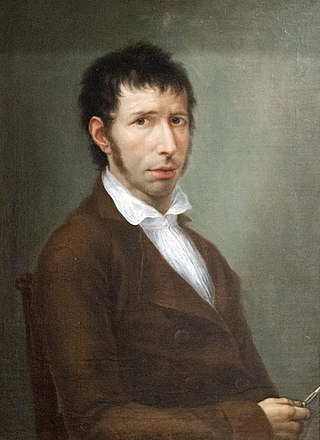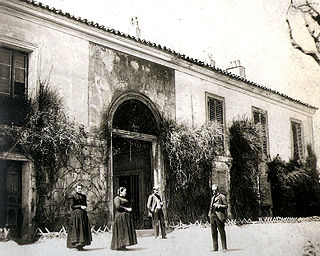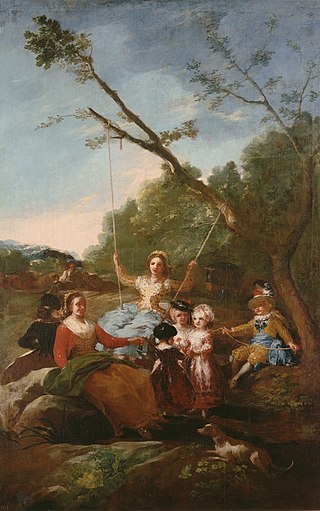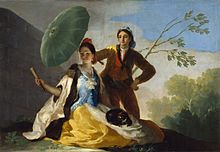
Francisco José de Goya y Lucientes was a Spanish romantic painter and printmaker. He is considered the most important Spanish artist of the late 18th and early 19th centuries. His paintings, drawings, and engravings reflected contemporary historical upheavals and influenced important 19th- and 20th-century painters. Goya is often referred to as the last of the Old Masters and the first of the moderns.

Francisco Bayeu y Subías was a Spanish painter in the Neoclassic style, whose main subjects were religious and historical themes. He is best known for his frescoes. His brothers Ramón and Manuel were also well-known painters.

Spanish art has been an important contributor to Western art and Spain has produced many famous and influential artists including Velázquez, Goya and Picasso. Spanish art was particularly influenced by France and Italy during the Baroque and Neoclassical periods, but Spanish art has often had very distinctive characteristics, partly explained by the Moorish heritage in Spain, and through the political and cultural climate in Spain during the Counter-Reformation and the subsequent eclipse of Spanish power under the Bourbon dynasty.

The Sleep of Reason Produces Monsters or The Dream of Reason Produces Monsters is an aquatint by the Spanish painter and printmaker Francisco Goya. Created between 1797 and 1799 for the Diario de Madrid, it is the 43rd of the 80 aquatints making up the satirical Los caprichos.

The Colossus, is known in Spanish as El Coloso and also El Gigante, El Pánico and La Tormenta. It is a painting traditionally attributed to Francisco de Goya that shows a giant in the centre of the canvas walking towards the left hand side of the picture. Mountains obscure his legs up to his thighs and clouds surround his body; the giant appears to be adopting an aggressive posture as he is holding one of his fists up at shoulder height. A dark valley containing a crowd of people and herds of cattle fleeing in all directions occupies the lower third of the painting.

A Pilgrimage to San Isidro is one of the Black Paintings painted by Francisco de Goya between 1819–23 on the interior walls of the house known as Quinta del Sordo that he purchased in 1819. It probably occupied a wall on the first floor of the house, opposite The Great He-Goat.

Ramón Bayeu y Subías was a Spanish Neoclassicist painter; known primarily for his work in tapestry design.

Christ Crucified is a 1780 oil-on-canvas painting of the crucifixion of Jesus by Spanish Romantic painter Francisco de Goya. He presented it to the Real Academia de Bellas Artes de San Fernando as his reception piece as an academic painter. It now forms part of the permanent collection of the Prado Museum in Madrid.

The Black Paintings is the name given to a group of 14 paintings by Francisco Goya from the later years of his life, likely between 1819 and 1823. They portray intense, haunting themes, reflective of both his fear of insanity and his bleak outlook on humanity. In 1819, at the age of 72, Goya moved into a two-story house outside Madrid that was called Quinta del Sordo. Although the house had been named after the previous owner, who was deaf, Goya too was nearly deaf at the time as a result of an unknown illness he had suffered when he was 46. The paintings originally were painted as murals on the walls of the house, later being "hacked off" the walls and attached to canvas by owner Baron Frédéric Émile d'Erlanger. They are now in the Museo del Prado in Madrid.

The Royal Tapestry Factory is a factory making tapestries in Madrid, Spain, which was founded in 1720 and is still in operation.

Summer or The Threshing Floor is the largest cartoon painted by Francisco de Goya as a tapestry design for Spain's Royal Tapestry Factory. Painted from 1786 to 1787, it was part of his fifth series, dedicated to traditional themes and intended for the heir to the Spanish throne and his wife. The tapestries were to hang in the couple's dining room at the Pardo Palace.

The Spanish royal collection of art was almost entirely built up by the monarchs of the Habsburg family who ruled Spain from 1516 to 1700, and then the Bourbons. They included a number of kings with a serious interest in the arts, who were patrons of a series of major artists: Charles V and Philip II were patrons of Titian, Philip IV appointed Velázquez as court painter, and Goya had a similar role at the court of Charles IV.

The Drunk Mason is an oil on canvas painted by Francisco de Goya, then reputed painter of tapestries for the royal palaces. It belonged to the fifth series undertaken by Goya, and, like all the pieces that compose it, was painted between 1786 and 1787.

Self-portrait at 69 years is an oil painting by the Spanish painter Francisco Goya. Two original versions of this work have been preserved. One of the paintings, painted on canvas, is housed in the collections of the Prado Museum. The other, created on wood panel, is located in the Real Academia de Bellas Artes de San Fernando in Madrid. Both paintings were created in 1815, in the post-war period, and depict a very similar image of the artist. This is one of the most sincere and direct self-portraits of the painter.

A Village Bullfight or A Village Corrida is an oil painting by the Spanish painter Francisco Goya.

The tapestry cartoons of Francisco de Goya are a group of oil on canvas paintings by Francisco de Goya between 1775 and 1792 as designs for the Royal Tapestry Factory of Santa Barbara near Madrid in Spain. Although they are not the only tapestry cartoons made at the Royal Factory, they are much the best known. Most of them represent bucolic, hunting, rural and popular themes. They strictly adhered to the tastes of King Charles III and the princes Charles of Bourbon and Maria Luisa of Parma, and were supervised by other artists of the factory such as Maella and the Bayeu family. Most are now in the Museo del Prado, having remained in the Spanish Royal collection, although there are some in art galleries in other countries.

The Swing is the title of a tapestry cartoon designed by Francisco de Goya for the bedroom of the Princes of Asturias in the Palace of El Pardo. It is kept in the Museo del Prado.

La novillada, is a painting by Francisco de Goya, painted in 1780, when he was trying his hand at bullfighting. It is part of the fourth series of tapestry cartoons for the Prince of Asturias' antechamber in the Pardo Palace.


















